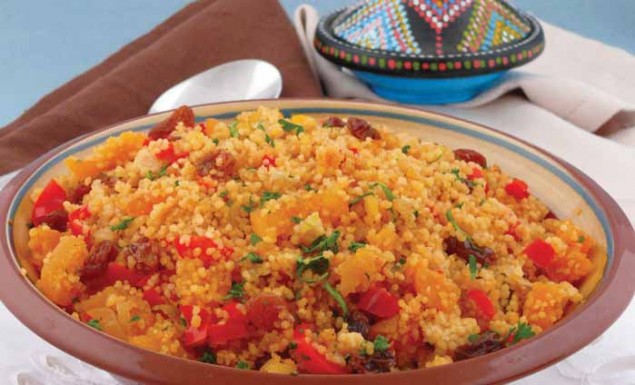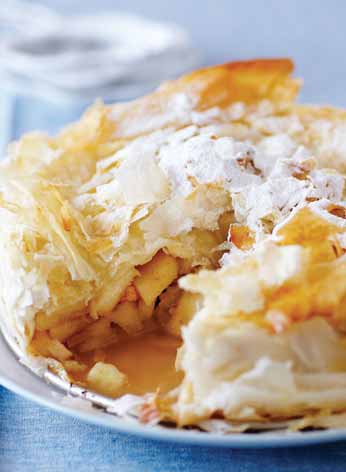Simanim–Sign Me Up for a Sweet, Healthy New Year!
Rosh Hashanah is usually associated with apples and honey, symbolizing sweetness for the coming New Year. In our family, honey cake, apple cake or strudel and a carrot tzimmes sweetened with honey are always on the menu. The following are recipes that include some of the special symbolic foods—the simanim—eaten on Rosh Hashanah: fish, pomegranates, carrots, honey, beets, dates, raisins and apples. Enjoy in good health!
BAKED SALMON WITH MUSHROOM STUFFING
Adapted from The NEW Food Processor Bible (Whitecap, 2010)
Makes 8 to 10 servings
This recipe works well with Arctic char, bass or any whole fish. The baked salmon is also excellent without the stuffing, but stuffing the fish turns it into an elegant dish. Garnish with lemon slices that have been dipped in chopped parsley.
4 to 5 lb whole salmon, scaled with head removed
(or 2 salmon fillets, 1 1/2 to 2 lb each)
3 cloves garlic
1/4 cup fresh dill
2 tablespoons fresh basil
1 tablespoon salt (or to taste)
Freshly ground black pepper to taste
1/2 teaspoon each dried thyme and dried oregano
2 teaspoons paprika
Juice of 1/2 lemon
2 tablespoons olive oil
2 large onions, halved
mushroom stuffing (optional) (below)
Preheat oven to 450°F. Wash salmon and pat dry. Place in well-sprayed, large glass baking dish.
Insert steel blade in food processor. Drop garlic through feed tube while machine is running; process until minced. Add dill and basil; process until minced. Rub fish with the minced mixture, salt, pepper, thyme, oregano, paprika, lemon juice and oil.
Insert slicer in food processor. Slice onions, using light pressure. Arrange onions around fish. If desired, stuff with mushroom stuffing just before baking. Cut slits in skin of fish on top side in 3 or 4 places.
Bake uncovered for approximately 30 minutes (allow 10 minutes cooking time for each inch of thickness). When done, fish should flake easily at the thickest point and the flesh should be opaque.
Note: Keeps 2 or 3 days in the refrigerator. Remove stuffing and store separately. Salmon freezes well.
Mushroom Stuffing:
Source: The NEW Food Processor Bible (Whitecap, 2010)
Makes 8 servings
This also makes a delicious stuffing for chicken. To use it as a stuffing for turkey, double the recipe.
1/2 cup fresh parsley
3 or 4 green onions
1 to 2 tablespoons olive oil
3 cups mushrooms
3/4 cup dried bread crumbs or matzo meal
2 to 3 tablespoons dry white wine
Salt and freshly ground black pepper to taste
Insert steel blade in processor bowl. Process parsley and green onions until minced. Sauté in olive oil in a nonstick skillet for about 2 minutes over medium heat. Coarsely chop mushrooms with several quick on/offs. Add to skillet and cook 2 to 3 minutes longer. Add remaining ingredients, using just enough wine to moisten stuffing. Mix well. Cool before using. (Can be made up to a day in advance and refrigerated.)
Stuff fish and fasten with skewers. Bake as directed above. Stuffing must be cooked until it reaches 165°F on an instant-read thermometer.
Do not freeze.
Variation: For fewer calories, substitute 2 cups cooked rice, couscous or quinoa for the bread crumbs Omit wine and add lightly beaten egg to bind the stuffing together. If desired, add other vegetables to boost the color and flavor (e.g.,grated zucchini, chopped red pepper, spinach).
 Mediterranean-style Couscous
Mediterranean-style Couscous
Photo: Douglas Gilletz
NORENE’S POMEGRANATE CHICKEN
Source: Norene’s Healthy Kitchen (Whitecap, 2007)
Makes 12 servings
This fragrant dish contains honey, carrots, and apricots–traditional foods served with hope for a sweet and fruitful New Year.
2 medium onions, sliced
2 cups baby carrots (or 2 cups peeled and sliced regular carrots)
2 whole chickens (3 1/2 lb each), cut into pieces
1 teaspoon dried thyme
Kosher salt and freshly ground black pepper
1 cup dried whole apricots, loosely packed
1 cup pitted whole prunes, loosely packed
2 teaspoons sweet paprika
Marinade:
1 cup pomegranate juice (or juice of 1 pomegranate)
2 cloves garlic (about 2 teaspoons minced)
Juice and rind of 1 lemon
1/3 cup balsamic vinegar
2 tablespoons extra virgin olive oil
2 tablespoons honey
Spray a large roasting pan with cooking spray. Scatter the onions and carrots in the bottom of the pan. Rinse the chicken well and pat dry with paper towels. Trim the excess fat. Place the chicken on top of the vegetables and sprinkle—under the skin and on top—with thyme, and salt and pepper to taste. Tuck the apricots and prunes between the chicken pieces. Whisk the ingredients for the marinade together in a bowl. (If using the juice of a whole pomegranate, reserve some of the seeds for garnish.) Pour over the chicken and sprinkle with paprika. Cover and marinate in the refrigerator for at least 1 hour or for as long as 2 days. When the chicken is marinated, preheat the oven to 350°F. Cook the chicken, covered, for 1 1/2 hours or until tender. Uncover and cook for 30 minutes longer, basting occasionally, or until the skin is golden. Remove the pan and let cool before refrigerating overnight. About 30 minutes before serving, remove and discard any congealed fat from the chicken. Reheat, covered, for 25 to 30 minutes at 350°F. Transfer the heated chicken to a large serving platter and sprinkle with pomegranate seeds. Serve immediately.
Note: Keeps for up to 3 days in the refrigerator; reheats
well. Freezes well for up to 4 months.
Chef’s Secrets: One pomegranate contains about 3/4 cup seeds and yields 1/2 cup juice.
No pomegranates? Substitute either bottled pomegranate or cranberry juice. If desired, sprinkle with toasted pumpkin or sesame seeds at serving time.
NORENE’S ROASTED BEET SALAD
Source: Norene’s Healthy Kitchen (Whitecap, 2007)
Makes 8 servings
Roast and boast! Roasting beets enhances the flavor, producing beets that are moist and tender. You can’t “beet” that! Boiling only lessens their flavor—once you try roasting, you won’t prepare them any other way.
2 lb fresh beets
3 tablespoons orange juice (preferably fresh)
3 tablespoons extra virgin olive oil
1 teaspoon Dijon mustard
1 teaspoon honey
1/2 cup thinly sliced red onions
Salt and freshly ground black pepper
Preheat the oven to 400° F. Scrub the beets well and then trim the stems and roots to within 1 inch. Spray a large piece of heavy-duty foil with cooking spray. Place the beets in the center and wrap tightly, pinching the edges of foil together. Bake for about 1 to 1 1/4 hours or until tender. (Beets are ready when a metal skewer glides easily through them.)
When fully roasted, remove from the oven, carefully open up the foil packet and let the beets stand until cool enough to handle. Using a paper towel, rub off the skins and then cut the beets into 1/4-inch-thick rounds. Arrange the beet slices on a platter and scatter with the onion slices.
Whisk together the orange juice, olive oil, mustard, and honey in a small bowl. Drizzle the mixture over the beets and onions, then sprinkle with salt and pepper to taste. Serve warm or at room temperature.
Note: Keeps for up to 2 or 3 days in the refrigerator.
Chef’s Secrets:
• Beet Me Up, Scotty! Choose fresh beets that are roughly the same size for even cooking. Large beets tend to be tough, so small-to-medium-sized are best, about 4 oz (125 g) each.
• Buffet Beauty: For a beautiful presentation, use both red and golden beets. Arrange them in separate piles on a platter so that the colors don’t bleed into each other. If golden beets aren’t available, alternate the beets with orange slices.
 Apple Strudel in the Round
Apple Strudel in the Round
Photo: Ryan Szulc
COUSCOUS, MEDITERRANEAN-STYLE
Source: Norene’s Healthy Kitchen (Whitecap, 2007)
Makes 8 servings
Experience the fabulous flavors of the Mediterranean with this colorful dish. You can use regular or whole wheat couscous, or try the pearl-shaped grains of pasta known as Israeli couscous (or maftoul), which are much larger and more versatile than the typical Moroccan couscous. You can replace the couscous with orzo (rice-shaped pasta), bulgur or quinoa.
2 tablespoons olive oil
2 medium onions, chopped
1 red pepper, seeded and chopped
2 cloves garlic (about 2 tsp minced)
1 1/2 cups couscous
1 teaspoon ground cumin
3 cups hot vegetable or chicken broth
1/2 cup raisins or currants
1/2 cup chopped dried dates or apricots
Salt and freshly ground black pepper
1/2 cup chopped fresh parsley or mint
1/3 cup toasted slivered almonds (optional)
Heat the oil in a large, deep skillet on medium heat. Add the onions, red pepper, and garlic; sauté for 6 to 7 minutes or until golden.
Stir in the couscous and cumin and cook for 2 minutes longer or until golden. Slowly add the hot broth and bring to a boil. Reduce heat to low, cover, and simmer for 10 to 12 minutes or until the couscous is tender.
Stir in the raisins, apricots, salt, and pepper. Sprinkle with parsley and almonds and serve.
Note: Keeps for up to 3 days in the refrigerator; reheats
well. Freezes well for up to 2 months.
APPLE STRUDEL IN THE ROUND
Makes 10 to 12 servings
This strudel is round in shape, symbolizing the circle of life and the cycle of a new year. The recipe comes from my friend Marcy Goldman, and is included in her latest cookbook, A Treasury of Holiday Baking (Whitecap, 2009).
8 to 10 cups peeled and sliced apples (use a semi-soft sweet variety such as McIntosh, Cortland or Golden Delicious, and cut apples into 1/8 to 1/4 inch wedges)
1/2 cup sugar
Juice of 1 lemon
1 teaspoon ground cinnamon
2 tablespoons cornstarch
1/4 cup yellow raisins plumped and dried
1/2 cup (1 stick) unsalted butter or margarine, melted
16 sheets filo dough
Confectioners’ sugar for dusting
In a large bowl, toss the apples with sugar, lemon juice, cinnamon, cornstarch, and raisins. Set aside.
Preheat the oven to 375°F. Lightly brush the bottom of a 10-inch springform pan with butter or margarine. Lay one sheet of filo on your work surface and generously brush it with melted butter or margarine. Top it with a second filo leaf, brush it with butter, and keep layering until you’ve used 9 sheets of filo. Gently press the sheets into the pan, allowing them to drape over the sides. Brush the top of filo with butter or margarine and spoon the apples into the pie shell, pressing gently. You should have enough apples to mound nicely, reaching slightly above the top of the pan. Fold the overlapped ends of filo over the apples (in any fashion—it all works out in the end).
Lay 3 more buttered filo leaves on top of the apples. Brush the top with butter or margarine. Fold the filo in, overlapping it in any fashion over the apples. With the remaining filo leaves, cut 4 circles the size of the spring form pan. Discard scraps or trimmings. Brush each with butter or margarine, including the top, and gently place on top of the apples. Make small knife marks in the pastry through to the apples in order to allow steam to escape.
Place the springform pan on a foil- or parchment paper lined baking sheet to catch the drippings. Set the cake on the lowest rack of the oven, and immediately reduce the heat to 350°F. Bake until the pastry puffs up and the apples begin to ooze juice (40 to 50 minutes). Cool very well before unmolding (20 to 30 minutes). Loosen the sides with a flat knife before pushing up the bottom. Just before serving, dust the strudel with confectioners’ sugar.
Norene Gilletz is a cookbook author and culinary consultant in Toronto. She is the author of seven cookbooks. For more information, visit her web site at www.gourmania.com
